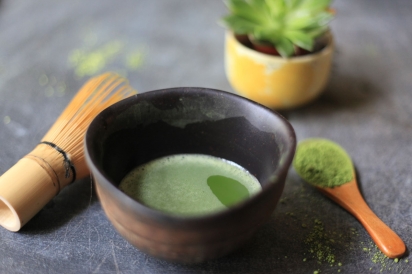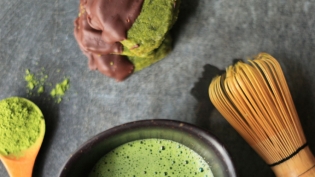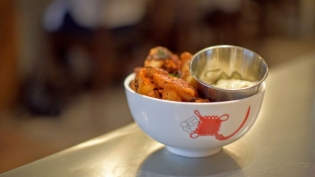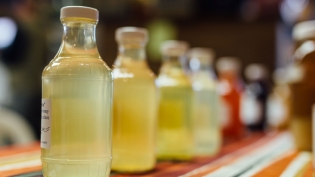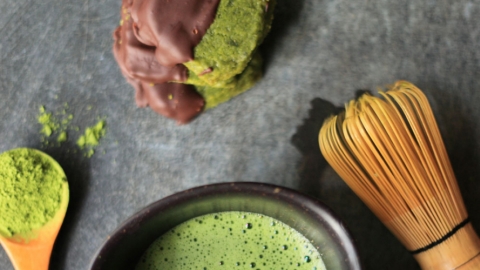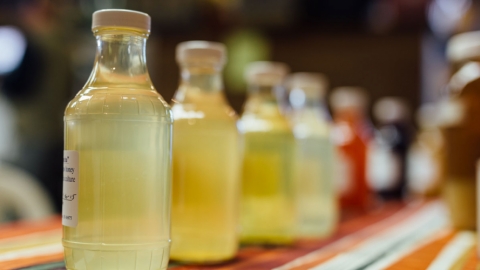Ancient matcha becomes trendy superfood
Kombucha. Coconut water. Shrubs. Cold-pressed juices. They’ve all had turns as the health drink in recent years. But matcha, an ancient powdered green tea, is poised to become known as the unparalleled powerhouse of liquid superfoods.
With its earthy, grassy aroma, subtly sweet, clean flavor profile and lush green hue, a cup of warm matcha is an ambrosial respite for the senses. But perhaps its biggest appeal lies in the myriad purported wellness benefits. The drink is brimming with antioxidants (some with touted cancer-fighting, heart-helping abilities), fiber and a smattering of vitamins and minerals. And because matcha is a finely ground powder of tea leaves added directly to water instead of being steeped and discarded, more of those health perks get passed along when it is consumed.
Another reason it has won over former espresso addicts: One serving of matcha contains about a third of the caffeine of coffee and provides a jitters-free energy lift thanks to its calming, slow-release properties. It soothes and improves alertness and concentration for hours.
“To drink matcha is relaxing,” says Yoshiko Green, a professor of Japanese language and culture at Indiana University, South Bend, who regularly performs traditional tea ceremonies across the Midwest. “It’s good not only for your health, but for your soul.”
Green tea has a rich history with roots in fourth-century China. The first ceremony involving tea was documented almost 500 years later, roughly around the same time that Japan began cultivating its first tea plants. In the late 12th century, a Japanese priest named Myoan Eisai returned home from his religious and philosophical studies in China with green tea powder, which he deemed the “elixir of the immortals.”
Matcha consumption and cultivation flourished in Japan. Growers eventually switched to covering the plants with thin tarps to provide shade, which boosted the chlorophyll—deemed a superfood in its own right—and gave matcha its iconic emerald green color. Zen Buddhists began to use the stone-ground leaves as part of their daily premeditation ritual to feel more centered and focused. That practice morphed into the tea ceremony that remains a revered custom throughout Japan.
Much like coffee aficionados appreciate the multistep process of preparing their brew in a French press or pour-over vessel, matcha drinkers tend to find the methodology almost meditative. “Matcha is special,” says Green. “It takes some time to make; it’s not quick like instant Lipton tea.”
To make a cup of matcha, add one or two teaspoons of the powder into a small cup. Add two to three ounces of hot (ideally at 175°, but never boiling) water, then vigorously whisk until the tea turns frothy. Start sipping.
If straight matcha is too robust or bitter for your taste, try pairing it with chocolate or butter cookies, or add it to warm milk with a touch of honey. The easiest way to do the latter is to heat the milk (preferably a dairy-free variety for the most health benefits, since cow milk contains a protein that reduces matcha’s potency) in a glass jar in the microwave, add a heaping teaspoon of matcha, put the lid on and shake until combined.
The verdant powder also plays well in a variety of food treatments, from ice cream and white chocolate truffles to bagels and pasta. Adding a bit of citrus zest makes it absolutely transcendent and, according to scientists, ups the body’s ability to absorb those antioxidants. You can add a spoonful to smoothies, pancake batter or pesto, or sprinkle it on top of your morning oatmeal or movie-night popcorn.
Ready to add matcha to your grocery list? There are two types: ceremonial grade (for drinking) and culinary, so buy the right one to suit your purposes. Ceremonial-grade matcha is derived from young green leaves that have been picked, steamed, dried and destemmed by hand, making it pricier than its cooking counterpart. Culinary matcha may contain more mature leaves or be machine-processed.
One last thing: Don’t be put off by the price tag. A small canister lasts a long time, and making a cup of matcha at home is a mere fraction of the price of that fancy bottle of kombucha on the store shelves.
Now, go get on the green bandwagon.



